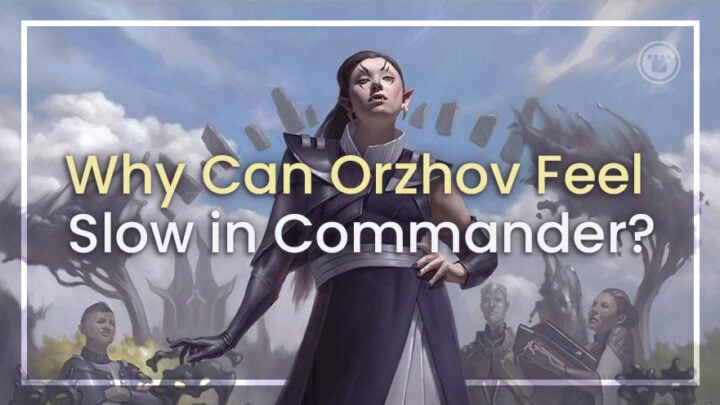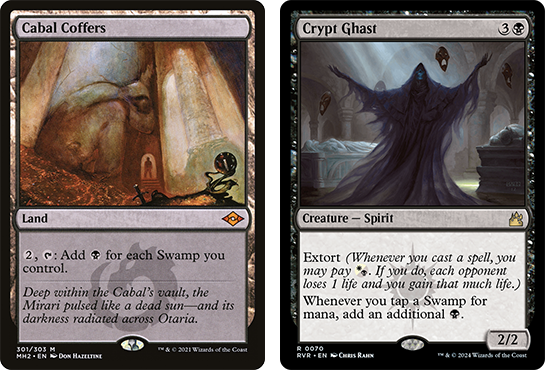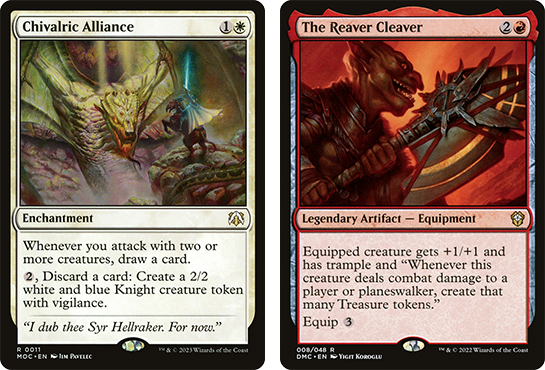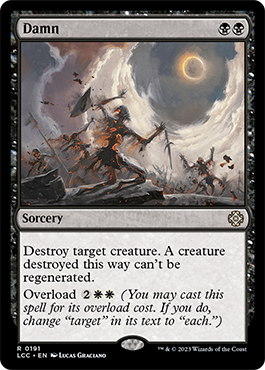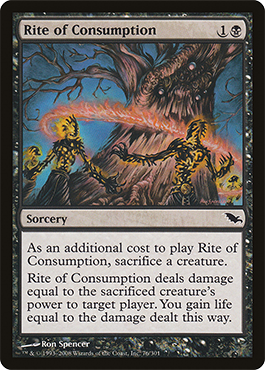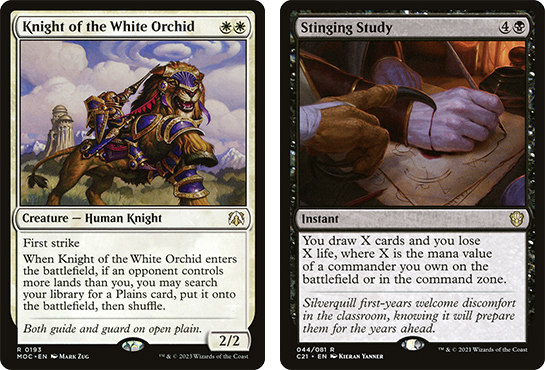Shockingly, different color pairs in Magic play and feel differently. The black white color pair, Orzhov, can sometimes feel a little slow in Commander. Kristen has some thoughts on why that is.
I love playing Commander, and there’s nothing I love more than brewing new and interesting decks. We’re spoiled for choice when it comes to picking something to brew, so I’ve played a lot of different colors and styles of deck over the years. Naturally, different colors play differently, and have different strengths and weaknesses. One color pair I’ve always felt underwhelmed by is Orzhov.

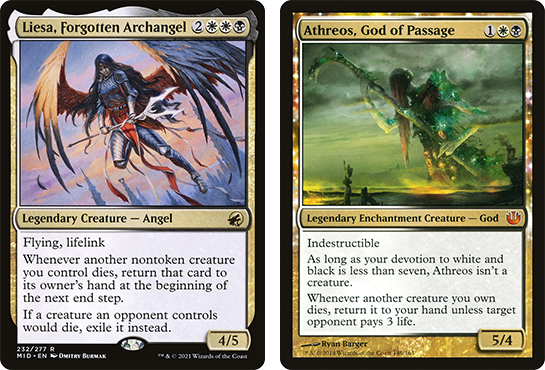

Liesa, Forgotten Archangel | Athreos, God of Passage
Elenda, the Dusk Rose | Kambal, Consul of Allocation | Drana and Linvala
I’ve played a lot of Orzhov decks in my time. From humble beginnings playing Ayli, Eternal Pilgrim with some janky-ass combos, to Teysa Karlov, Regna & Krav partners, Nalia de’Arnise and other precons, both Liesa, Shroud of Dusk and Liesa, Forgotten Archangel (two very different decks), I’ve tried many different styles. Aristocrats, Reanimator, Combo, Taxes, Party, Tokens… and yet, most of these decks were plagued by similar issues inherent to playing Orzhov.
My latest build, Felisa, Fang of Silverquill, isn’t immune to some of the pitfalls of playing Orzhov either, so let’s dig into them.
ORZHOV FEELS SLOW IN COMMANDER
Overwhelmingly, playing Orzhov feels slow to me. Of all of the white decks, it’s the one that most often ends up behind on land drops. Obviously when you add green you have no problem ramping; blue helps you draw cards in less resource-intensive ways; adding red gives you a much punchier strategy that can take better advantage of equipment in order to ramp.
While BW decks have access to Cabal Coffers, Crypt Ghast and enchantments like Life Insurance, they tend to have to jump through the hoops of sacrificing their own resources in order to get ahead on mana. Pitiless Plunderer needs your board to die to make treasures, and it’s the same with most of the other sources of bursty mana generation in the color pair. Even lands like Cabal Coffers rely on Urborg to be good, and Lake of the Dead asks you to sacrifice your swamps for bursts of mana, leaving you behind.
While not having access to green isn’t exclusive to Orzhov, UW and RW decks can gain resources by advancing their board state.
Azorious can use the same catchup ramp that Orzhov can, but it can better leverage it using its more extensive access to flicker effects and its easier access to card draw that doesn’t require putting bodies through the meat grinder.
Boros decks can now draw cards for attacking, and their access to ways to tutor and equip the myriad of equipments that generate mana like Sword of Hearth and Home, Sword of the Animist and The Reaver Cleaver mean that they can often times end up ahead of even the green decks at the table.
Before we get into the identity crisis that Orzhov can sometimes face – due to social contracts, largely – I want to talk about another aspect that hampers Orzhov decks in practice: sequencing.
DRAWING THE CARDS IN THE RIGHT ORDER
The best performances Orzhov decks can deliver are when they sequence their cards correctly. For a color pair that is intent on sacrificing resources to generate card and mana advantage, it’s one that is also inherently bogged down by needing to sequence cards in a certain way, and keep them on the board, to begin to accrue that value. Even if you’re not wanting to play an A+B combo win condition, many Orzhov cards feel A+B in the sense that you need to draw the fodder, or ways to make fodder, before you draw the ways to sacrifice or use them for value.
This can feel quite frustrating, given the fact that the same fodder you use to achieve your goals can end up as casualties along the way. Whether you chump block with them or they die in board wipes, you’re going to end up playing many games where you curve out only to lose your board before you can really get that engine humming along.
Orzhov decks want to play in the graveyard, but they can’t do it as efficiently and bursty as a Golgari deck. They want to attack, but without the haste and access to bursts of draw that you’d get in a Boros or Rakdos deck, it can feel like assembling a winning position takes longer. They also want to play Control, and despite not having access to the draw you get in Azorious, they do actually manage to play Control well.
ORZHOV IS A CONTROL COLOR
It might be news to you, especially if you play Commander more for fun, or because you enjoy a particular character or creature type, but Orzhov is a control color pair. The reason Esper decks are often seen as the pinnacle of Control is because they combine Orzhov’s removal with blue draw.
The rub is that many Orzhov decks in Casual Commander find that playing those efficient board wipes and controlling strategies runs in opposition to the “Midrange value” midline that encapsulates the casual approach to the format.
Playing a wrath, for instance, runs counterintuitively to curving out. How do you embrace this strategy when playing the Party Time precon, for example? Or, when you’re playing a more go wide approach?
EMBRACE ORZHOV STRENGTHS FOR MORE SATISFYING GAMES
Much like mono-black, many Orzhov Commanders promote a style of gameplay or deckbuilding that, when built optimally, can sometimes dip into the “anti-social” realm of the social contract. One aspect of this is in the aristocrats + edicts synergy.
Orzhov tends to want to sacrifice its creatures for treasures or card draw, and by going down on on-board resources to try and generate more, you’re only ever really breaking even on value. In order to make this less of a hit to your gameplan – and to make a dent in your opponents – you can combine this approach with cards that make your opponents sacrifice their creatures.
Grave Pact, Dictate of Erebos and Martyr’s Bond all make that loss of a creature or other permanent symmetrical by forcing opponents to lose resources also. The problem with running these cards is that without a solid gameplan and path to a win condition, the soft-lock that they can exert on a table (particularly when combined with edict creatures like Accursed Marauder and Plaguecrafter) can prove to ultimately be quite boring.
Commander games are the most engaging when there’s a natural ebb and flow to how things play out, and control strategies that grind gameplay to a halt are frowned upon by many casual players. The issue is that for Orzhov to not be left behind at a table – especially when it comes to the less mana efficient or older Commanders – embracing the color pair’s strengths can feel necessary for consistency.
JUST PLAY THAT COMBO
Win conditions are important, and it’s one reason why the Orzhov strategy of winning by “death by one-thousand cuts” is at the heart of most strategies. Leveraging lifegain while draining your opponents does help to close a game, but without embracing Orzhov’s identity as a controlling color pair, your efforts might ultimately feel fruitless.
When your Orzhov deck feels like it runs out of gas, or that sequencing is overly important; when your Orzhov deck feels like it falls behind on board state and mana, and when you’re conflicted about dropping a wrath, then what’s the solution? What if you still don’t want to use the aristocrats + edicts engine, because you either lack the shell to make it sing, or you don’t enjoy the gameplay?
Well, you need to embrace the other strengths of being a control color, and add in more win conditions. Whether that’s an A+B combo like Sanguine Bond and Exquisite Blood, or a loop with Gravecrawler and Phyrexian Altar with a Blood Artist or similar in play, you should be comfortable in approaching the game in the way that your color pair is most comfortable.
If those combos aren’t your thing, then you should consider how to convert a board of tokens or small value creatures into a win condition with a card like Moonshaker Cavalry. You should look to a card like Rite of Consumption to “Fling” your large creature piled with +1/+1 counters on it in order to eliminate a player and keep yourself alive.
What’s more, it will pay to diversify the ways in which you generate value. As well as a Pitiless Plunderer, run a Knight of the White Orchid. Add Stinging Study as well as Grim Haruspex. You don’t want to be stuck in situations where you can’t get an engine going.
END STEP
Often we are drawn to playing a color pair because we like the Commander and the playstyle it offers. Other times it’s because we enjoy the art, flavor or effects of the spells in our collection and want to jam them into a deck. Whatever the reason, it can sometimes be easy to forget that playing to a color’s strengths is what can enable us to build more cohesive decks – and ultimately, decks that are more enjoyable to play.
Orzhov feels like it can suffer even more from this in some ways because it has to negotiate the social aspect of leaning into its more controlling and grindy nature. If you’re worried about slowing things down even more, then be sure to consider whether a combo is right for your deck. It could be the key to ending games before they outstay their welcome.

Kristen is Card Kingdom’s Head Writer and a member of the Commander Format Panel. Formerly a competitive Pokémon TCG grinder, she has been playing Magic since Shadows Over Innistrad, which in her opinion, was a great set to start with. When she’s not taking names with Equipment and Aggro strategies in Commander, she loves to play any form of Limited.

